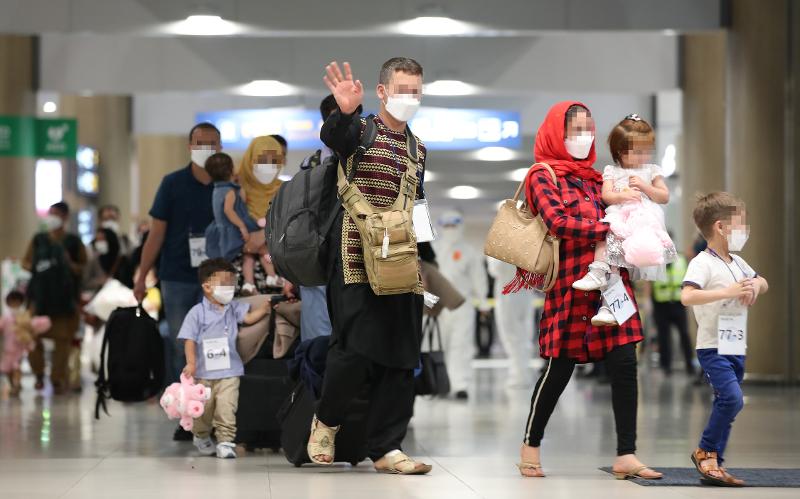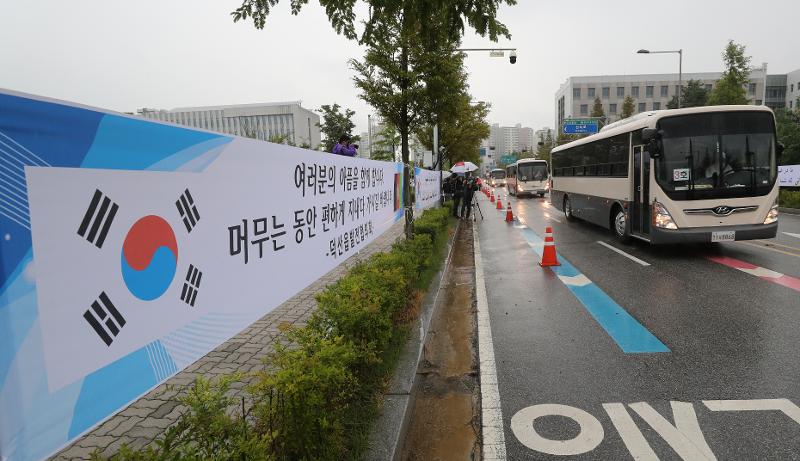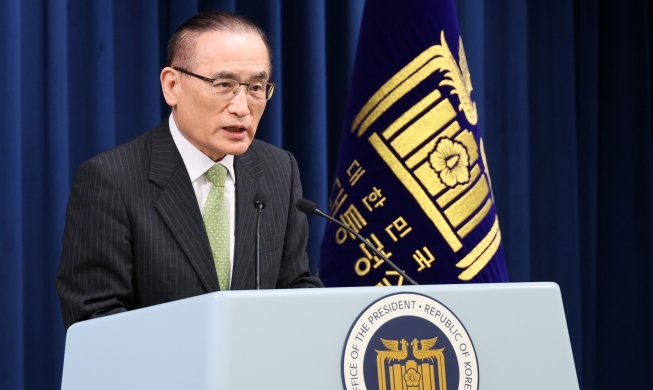
Afghan evacuees and their families who helped the Korean government in Afghanistan on Aug. 26 walk toward a bus headed for temporary quarantine facilities after arriving at Incheon International Airport on a Korean military transport plane. (Yonhap News)
By Yoon Sojung
''I got a lump in my throat as if a miracle occurred.''
Deputy Minister for National Defense Policy Kim Man-gi, who heads the ministry's Defense Policy Office, on Aug. 26 recalled this feeling after receiving a final report saying all Afghan evacuees were gathered at Islamabad International Airport in Pakistan to board a flight to Korea on a Korean military transport plane.
Through what the official called a ''miracle,'' 377 Afghan staff on Aug. 26 arrived safely at Incheon International Airport in what was called Operation Miracle.
The Afghan evacuees were staff who helped Korean government activity in Afghanistan. They departed the Afghan capital of Kabul on a Korean military transport plane and flew to Korea via Islamabad, and were granted residence in Korea not as refugees, but "special people of merit."
On Aug. 27, they arrived at their temporary accommodations, Innovative Leadership Campus, in Jincheon-gun County, Chungcheongbuk-do Province, for a six-week stay to start life in their new country. They will receive education there on adjusting to Korea like classes in the Korean language and culture.
Like the operation's name, Deputy Minister Kim said the entire process of the evacuation was a miracle given the Taliban's strict and tight surveillance.
In a written interview with Korea.net, he described the keys to the operation's success and its significance.
- What was the most difficult part of Operation Miracle and how was it resolved?
One of the most difficult things was gathering all of the Afghan staff to the Kabul airport. As seen by the Aug. 26 explosions at the airport that were apparently suicide bombings, the Kabul region is a military danger zone. Our military had to make an unprecedented long-distance flight of 20,000 km to a conflict region to bring the Afghans safely to Korea. The Taliban had earlier destroyed a Korean hospital and job training center in Bagram, so we had insufficient time to prepare for the operation at a time when the evacuees' safety was threatened. It was impossible for the Afghan staff to get into the Kabul airport given the airport's chaotic-like situation after some 20,000 people gathered there.
Under these circumstances, the Ministry of National Defense carried out Operation Miracle to safely get the evacuees out. After forming a special task force of 66 ministry and Air Force staff, we sent on the early morning of Aug. 23 a military aerial tanker (KC-330) and two military transport planes (C-130J) to the region. For the transport plane that directly entered Kabul, we had to install missile warning and missile avoidance flare systems.
Because of Taliban searches at checkpoints and the congested gate at the Kabul airport, the Korean mission team in Afghanistan judged that getting into the airport was hard and decided to use buses to get the evacuees into the airport. Through social media, a task force of staff from the Korean Embassy in Kabul and the Ministry of National Defense told the evacuees when and where to gather. Thanks to military cooperation from our allies including the U.S., we succeeded in getting them inside the airport.
Afterwards, we immediately sent two C-130J transport planes on standby in Islamabad to the Kabul airport to safely take the evacuees to the Islamabad airport on the afternoon of Aug. 25. Because gathering all of the evacuees at the airport was one of the hardest tasks, I got a lump in my throat as if a miracle occurred when I received the final report that we gathered them at the airport.
In the process of transporting the evacuees to Korea from Islamabad, we tried to find the best way to take them by considering their sex, ages and health conditions. Because they had many toddlers and newborns, we decided to put all family members on the same plane and not separate them for their psychological stability. If the evacuees lacked seats, our military personnel showed their devotion by offering theirs and standing for the entire duration of the flight.

- How did Korea succeed in its evacuation while other countries did not?
Above all, I believe it was the devoted activities of staff based in the region from related agencies like the Ministry of National Defense, the Air Force and the Ministry of Foreign Affairs. I also want to point out the regular and smooth communication system created between the evacuees and staff at Korean embassies and ethnic Korean residents in the region. We also received a lot of hidden support. Personnel at the Korean Embassy in Kabul and a Defense Ministry task force were urgently dispatched to the Kabul airport, and struggled to secure buses to transport the evacuees on their own. The Korean Embassy in Pakistan offered vehicles and its buildings to the task force as accommodations. Korean expats in Pakistan also offered as accommodations facilities that had been closed due to COVID-19. Thanks to the emergency communications system using social networking services built by the embassies and staff there, we were able to quickly gather the evacuees at the designated time and place.
More than anything else, full cooperation from the U.S. enabled our operation to succeed. To gather the evacuees at the Kabul airport, we had to dispatch to the airport former staff from the Korean Embassy there who had gone to Qatar as an advance team. The U.S. military offered critical aid in the form of a military plane that allowed the urgent dispatch of three embassy staff and one military officer from the Korean Embassy in the United Arab Emirates. We also needed prior permission required (PPR) from the U.S. military to take off or land at the Kabul airport. We frequently requested PPR as the situation at the airport kept changing from time to time. The U.S. accepted and approved all of our requests without a single rejection.
- How significant was this operation?
As far as I know, this is the first time that our government rescued non-Koreans abroad from a life or death situation by actively utilizing human resources and assets for humanitarian purposes. Granting residence to the evacuees as special people of merit, not refugees, is also meaningful because by doing so, our nation fulfilled its responsibility for those who helped us. I believe that this decision befitted Korea's international status as a developed country. And a major implication is how Korea showed that despite any hardship, it proved itself as a country that utilized its military and diplomatic capacities to complete a mission.

Buses carrying Afghan evacuees on Aug. 27 enter their temporary accommodations at Innovative Leadership Campus in Jincheon-gun County, Chungcheongbuk-do Province. (Yonhap News)
